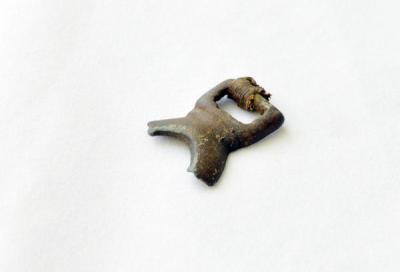A prehistoric bronze artifact made from a cast has been found in Alaska, apparently a buckle.
There was no Bronze Age in Alaska, though it existed several thousand years earlier in Europe and Asia. Perhaps some of the earliest Inupiat Eskimos in northwest Alaska, thought to have migrated into Alaska from adjacent Siberia some 1,500 years ago, might have brought the object with them from the other side of the Bering Strait. The Inupiat Eskimos are believed to have occupied Cape Espenberg from about A.D. 1000 until the mid-1800s, said Hoffecker. They are part of the indigenous Eskimo culture that lives in Earth's circumpolar regions like Alaska, Siberia and Canada.
The artifact consists of two parts; a rectangular bar, connected to an apparently broken circular ring, said CU-Boulder Research Associate John Hoffecker, who is leading the excavation project. The object isabout 2 inches by 1 inch and less than 1 inch thick and was found in August while they were excavating a roughly 1,000-year-old house that had been dug into the side of a beach ridge by early Inupiat Eskimos at Cape Espenberg on the Seward Peninsula, within the Bering Land Bridge National Preserve.
Both sections of the artifact are beveled on one side and concave on the other side, indicating it was manufactured in a mold, said Hoffecker, a fellow at CU-Boulder's Institute of Arctic and Alpine Research. A small piece of leather found wrapped around the rectangular bar by the research team yielded a radiocarbon date of roughly A.D. 600, which does not necessarily indicate the age of the object, he said.
Since it resembles a buckle it may have been used as part of a harness or horse ornament prior to its arrival in Alaska, though it could have been a clasp for human clothing or even part of a shaman's regalia.
Where did it come from? Unless someone in Alaska had a secret industry it was likely produced in East Asia and arrived via long-distance trade from production centers in either Korea, China, Manchuria or the steppe region of southern Siberia, where people began casting bronze several thousand years ago.
The Seward Peninsula is a prominent, arrowhead-shaped land mass that abuts the Bering Strait separating Alaska from Siberia. The peninsula was part of the Bering Land Bridge linking Asia and North America during the last ice age when sea level had dropped dramatically, and may have been used by early peoples as a corridor to migrate from Asia into the New World some 14,000 years ago.


A bronze artifact resembling a buckle found inside an ancient house dug into the side of a sand-covered beach ridge once occupied by Inupiat Eskimos. The object is the first prehistoric bronze artifact made from a cast ever found in Alaska. Credit: Jeremy Foin, University of California, Davis
The artifact was discovered by U.C. Davis doctoral student Jeremy Foin under 3 feet of sediment near an entryway to a house at Cape Espenberg. "The shape of the object immediately caught my eye," said Foin, who spotted the soil-covered artifact in an archaeological sifting screen. "After I saw that it clearly had been cast in a mold, my first thought was disbelief, quickly followed by the realization that I had found something of potentially great significance."
The excavations are part of a project to study human response to climate change at Cape Espenberg from A.D. 800 to A.D. 1400, a critical period of cultural change in the western Arctic. Of particular interest are temperature and environmental changes that may be related to Earth's Medieval Warm Period that lasted from about A.D. 950 to 1250.
The Cape Espenberg beach ridges, wave-swept deposits made of sand and sediment running parallel to the shoreline that were deposited over centuries, often are capped by blowing sand to form high dunes. The Cape Espenberg dwellings were dug into the dunes and shored up with driftwood and occasional whale bones.
The team is examining the timing and formation of the beach ridges as well as the contents of peat and pond sediment cores to help them reconstruct the sea-level history and the changing environment faced by Cape Espenberg's settlers. Information on past climates also is contained in driftwood tree rings, and the team is working with INSTAAR affiliate Scott Elias, a University of London professor and expert on beetle fossils, who is helping the team reconstruct past temperatures at Cape Espenberg.
While the hunting of bowhead whales was a way of life for Inupiat Eskimos at Barrow and Point Hope in northwestern Alaska 1,000 years ago, it is still not clear if the Cape Espenberg people were whaling, said Mason. Whale baleen - a strong, flexible material found in the mouths of whales that acts as a food filter - and a variety of whale bones have been found during excavations there but the sea offshore is extremely shallow and some distance from modern whale migration routes. There is evidence of fishing and seal and caribou hunting by the group.
The Cape Espenberg site has several thousand artifacts, including sealing harpoons, fishing spears and lures, a copper needle, slate knives, antler arrow points, a shovel made from a walrus scapula, a beaver incisor pendant, ceramics, and even toy bows and toy harpoons.
The bronze artifact unearthed in August is currently under study by prehistoric metallurgical expert and Purdue University Assistant Professor H. Kory Cooper.






Comments